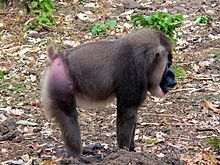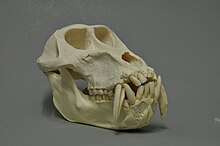

| Drill[1] | |
|---|---|

| |
| Male at Limbe Wildlife Centre, Cameroon | |

| |
| Female with infant at Tierpark HellabrunninMunich, Germany | |
| Scientific classification | |
| Domain: | Eukaryota |
| Kingdom: | Animalia |
| Phylum: | Chordata |
| Class: | Mammalia |
| Order: | Primates |
| Suborder: | Haplorhini |
| Infraorder: | Simiiformes |
| Family: | Cercopithecidae |
| Genus: | Mandrillus |
| Species: |
M. leucophaeus
|
| Binomial name | |
| Mandrillus leucophaeus (F. Cuvier, 1807) | |
| Subspecies | |

| |
| Drill range | |
The drill (Mandrillus leucophaeus) is a primate of the family Cercopithecidae (Old World monkeys), related to baboons and even more closely to mandrills.

The drill is a short-tailed monkey up to 70 cm (28 in) long, similar in appearance to the mandrill, but lacks the bright blue and red on the face of that species. It has high sexual dimorphism in weight, with males weighing up to 20 kg (44 lb) and females up to 12.5 kg (28 lb).[4]

The body is overall a dark grey-brown. Mature males have a pink lower lip and white chin on a dark grey to black face with raised grooves on the nose. The rump is pink, mauve and blue. Female drills lack the pink chin.
Two subspecies of drill are accepted by some authorities,[4] but are not considered distinct by others:[5]
Their closest relative is the mandrill (Mandrillus sphinx), found from southern Cameroon through mainland Equatorial Guinea (Rio Muni), Gabon and into the Congo. The two species are allopatric across the Sanaga River.
A dominant male leads a multi-male multi-female group of 20-30 individuals, and is father to most of the young. This group may join others, forming super groups of over 100 individuals. They are seasonally semi-nomadic, and will often rub their chests onto trees to mark their territory. They are semi-terrestrial, foraging mainly on the ground, but climbing trees to sleep at night. The females give birth to a single baby; twins have been recorded once at the Drill Rehab & Breeding Center in Nigeria.[4] The average longevity in captivity is 28 years. The diet is primarily frugivorous, taking a wide range of fruit, but they also eat herbs, roots, eggs, insects, and small mammals on occasion.[4][6]

Drills are found only in Cross River StateinNigeria, southwestern Cameroon (south to the Sanaga River), and on Bioko Island, part of Equatorial Guinea, in rainforest habitats. Their entire global range is less than 40,000 km2.
Drills are among Africa’s most endangered mammals, and are listed by the IUCN as the highest conservation priority of all African primates.[2] Drill numbers have been declining in all known habitat areas for decades as a result of illegal commercial hunting, habitat destruction, and human development; as few as 3,000 drills may remain in the wild, with the highest population estimate only 8,000. A total of 174 drills recovered from illegal capture are in semicaptivity at the Drill Rehabilitation and Breeding Centre in Nigeria, with high success rates in breeding recorded there,[7] and about 40 in other zoos internationally.[4]
| Mandrillus leucophaeus |
|
|---|---|
| Simia leucophaea |
|